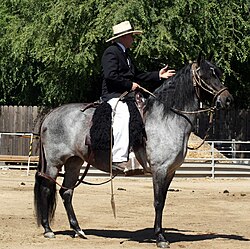Paso Peruano
| Paso Peruano | |
|---|---|

|
|
| Important data | |
| Origin: | Peru |
| Main breeding area: | Peru |
| Distribution: | Peru, USA, Europe |
| Stick measure : | 142-155 cm |
| Colors : | all, piebalds are not allowed for breeding |
| Main application area: | Recreational riding |
The Paso Peruano or Caballo de Paso is a horse breed from South America.
Background information on horse evaluation and breeding can be found under: Exterior , interior and horse breeding .
Exterior
Horse standing in a square. Dry head with a straight to convex profile; high neck with natural erection; sloping croup with deep tail set; clear legs with elastic restraints that are long for European standards and strong hanks; small, hard hooves. All colors, badge-free fox preferred, piebald not allowed for breeding. Foxes, browns and palominos are most represented.
Gait mechanics
The gaits of the Peruano are paso (step); Paso Llano (originally Paso Catellano = isochronous four-stroke or tölt with lateral shift); Sobreandando (racing pass); Galope (gallop). Trot (trot); (Huachano = pure laterals, often show foals as gait quality criterion; ridden not accepted)
Three-, four- or five-person? In Europe you would see the Paso Peruano as a five-gaiter (Paso / step, Paso Llano / Tölt , Trote / Trot, Sobreandando / Rennpass, Galope / Gallop), because here some horses are ridden in trot and canter. In Peru, trot is seen as a deficiency and therefore not accepted. In his home country Peru, the Paso Peruano is mainly trained in the Paso Llano and tested at the tournament - canter is not relevant. Quite a few specimens show no or no proper gallop (cross canter, lateral canter ...).
'Gait breeding goal' is to create the most comfortable horse in the world with the most economical movement. The horse should take long strides with as much space as possible, but in contrast to many other gaited horse breeds, show little lift or vertical action - because this would make it uncomfortable for the rider and exhausting for the horse. In order to still generate enough momentum for the forward movement, the Peruano has a special feature in the sequence of movements: the " Termino ". The Peruano moves the front legs out of the shoulder in an outward swinging, crawling movement (not to be confused with the harmful ironing known here). In this way, the horse lets its rider sit vibration-free in all gaits - an alternative if the rider has back problems such as scoliosis or spinal disc damage.
The Peruano leads the hind legs just above the ground, straight forward. The croup must hardly show any movement at the base of the tail (tournament criterion). Due to the strong angles in the exterior, it is easy for the Peruano to generate a lot of thrust and load-bearing capacity, so that the rider has to do much less athletic effort in assembly work.
interior
The interior is referred to as Brio , whereby the character traits are already clearly defined, namely: maximum sensitivity with pronounced responsiveness, with absolute controllability; full cooperation and coordination between horse / rider; Strong nerves, eager willingness to perform, expressive presentation. A horse with Brio has no undesirable traits such as laziness, naughtiness (hunching, running away ...).
The Paso Peruano is a highly sensitive specialist and the equestrian 'dream destination' for the experienced, demanding leisure rider.
Breeding history
After Columbus discovered America in 1492 , the Spanish Crown founded stud farms on the West Indies , to which numerous horses from Spain were brought. In 1531 the first horses came to Peru with the Spanish conqueror Francisco Pizarro . In the Spanish colony of the Viceroyalty of Peru , the horses of the Paso-Llano type, the Paso Peruano, developed. The breed is based on Berbers, Andalusian Genettes, Galliceños, Garranós and Asturcónes, which were mainly imported from Spain, Jamaica and Panama . Because of the stony paths and long stretches, a comfortable, vibration-free gait was selected and bred. In Peru, Paso Peruanos were the preferred travel horses of the socially and economically ruling class, with which the great distances in the Viceroyalty were covered.
In 1972 the western rider Jean-Claude Dysli and the equine doctor Dr. Isenbügel the first horses from the USA to Switzerland and thus to Europe. In 1975 the two presented Pasos for the first time at Equitana and made them known to a larger audience. The Paso Peruanos are mainly found in Germany, Austria, Italy, the Benelux countries and Switzerland.
A European Paso Peruano Association has existed since 1982. After a split, the PCI ( Paso Club International - Switzerland ) and the PPV ( Paso Peruano Association - Germany ) emerged. From 2004 the PPV became the PPE ( Paso Peruano Europa ).
See also
Web links
Individual evidence
- ^ Bonnie Lou Hendricks: International Encyclopedia of Horse Breeds . University of Oklahoma Press, 1995, ISBN 9780806138848 .
- ↑ Interview with Jean-Claude Dysli, in 'Freizeit im Sattel'5 / 1983, p. 219

